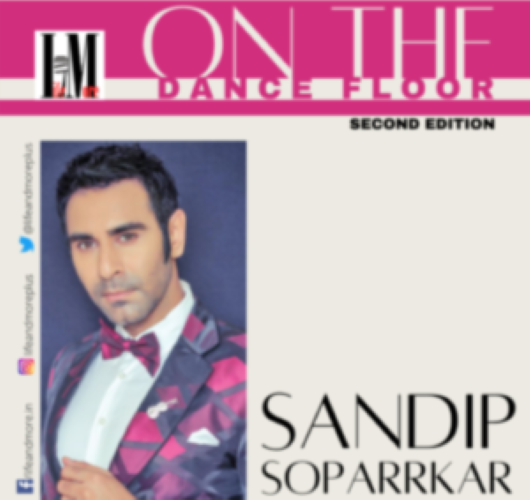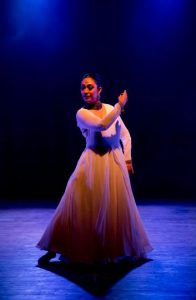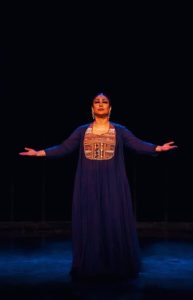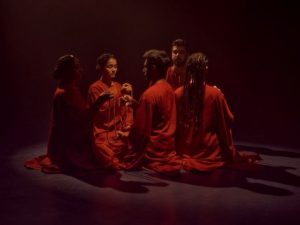Formless Form, Timeless Rhythm: Inside Sanjukta Sinha’s World of Dance

With her commanding stage presence and deeply evocative artistry, Sanjukta Sinha has emerged as one of the most compelling voices in contemporary Kathak. A dancer, choreographer, and creative visionary, she continues to push the boundaries of the classical form while staying rooted in its spiritual essence. In this candid conversation, she reflects on her training, creative inspirations, and the challenges of carving an independent path in today’s demanding dance landscape. Excerpts from an interview:
Your journey in dance has been both deep and diverse. Can you tell us about your training and how it shaped you as an artist?
My training has truly defined my artistic journey—it has been a process of profound learning and self-discovery. The years I spent in Lucknow were foundational, as I trained under the expert guidance of Late Pt. Arjun Mishra ji. Those were the years when I absorbed the core essence of Kathak: its rhythm, its storytelling, its conversation between movement and music. Guruji’s emphasis on lay and abhinaya—rhythm and expression—instilled in me the discipline and devotion that continue to guide my work today.
Later, my journey took me to Ahmedabad, where I had the privilege of learning under Padma Vibhushan Kumudini Lakhia ji. That phase was transformative. Her ability to preserve tradition while constantly exploring new creative directions opened my mind to Kathak’s infinite possibilities. She encouraged me to question, to reinterpret, and to look beyond the familiar. Under her mentorship, I began to understand the deeper spiritual and emotional layers that Kathak embodies. Those years of learning, practice, and reflection have culminated in a tapestry of experiences—each performance I present today is, in many ways, a tribute to the maestros who have inspired and shaped me.

Your production Eka has received wide acclaim. What inspired you to create it?
As a young dancer, I was profoundly moved by Priyadarsini Govind ji’s legendary performance of ‘Devi’. Her interpretation of feminine power, grace, and divinity left a lasting impression on me. Eka was born from that inspiration—it is an offering rooted in devotion, discipline, and the strength of the feminine spirit.
Over the years, I’ve sought to create a space where language is not a barrier—where dance becomes a universal mode of communication. Eka embodies that idea. It is about finding unity in diversity, about exploring a formless form and timeless rhythm. Through this work, Kathak engages in a conversation with both Hindustani and Carnatic classical traditions. It’s a collaborative dialogue between movement and live sound—each note, each gesture, a shared offering.
The ensemble brings together extraordinary musicians: Jayan Nair on vocals, Joby Joy on tabla and pakhawaj, Partha Sarkar on flute, and Manav Nair on mridangam and kanjira. Together, we explore not just the technical harmony between music and dance, but the emotional and spiritual resonance that connects them.
You’ve also choreographed ‘Sacred Bells’, another significant work. Tell us about its concept.
Sacred Bells is a reflection on the power of sound—not merely as something to be heard, but as something to be felt. It explores vibration, silence, rhythm, and stillness, where movement becomes meditation and sound transforms into spirit. The production examines how sound connects us—to the divine, to each other, and to our inner selves.
The music, composed by Bernhard Schimpelsberger, forms the heartbeat of the piece. The production was realized by Icecraft Production House under the creative direction of Mr. Chirag Mehta, with Pankaj Sihag providing visual direction. I was fortunate to work with an extraordinary ensemble: Krutika Ghanekar, Bhakti Dani Shah, Pankaj Sihag, Vihanga Rukshan, and Shantanu Gosavi—each of whom brought a unique energy to the stage. The costumes, designed by Naqsh, and the visual identity created by Shantanu Gosavi, completed the aesthetic language of Sacred Bells.
In essence, Sacred Bells is about discovering stillness within motion—it is an invitation to experience the sacred through the senses.
Your show Leela opened with great aplomb, tell me more about it.
Leela is an immersive and visually captivating dance production that reimagines the timeless spiritual love story of Krishna, Radha, and the Gopis in the sacred town of Vrindavan. Drawing inspiration from India’s rich cultural and spiritual heritage, it brings alive the essence of devotion, longing, and transcendental love through a mesmerizing blend of classical Indian dance, evocative music, and expressive storytelling.
Set against the radiant night of Vrindavan, the performance traces Radha and the Gopis’ emotional journey—from yearning for Krishna’s divine presence to the realization of love’s spiritual essence. Through intricate choreography and soul-stirring music, Leela portrays virah (separation) as a path to understanding true love and the divine connection beyond the physical realm.
Blending music, dance, and narrative, Leela transports audiences into a mystical world where love, devotion, and divinity merge, celebrating the universal and timeless power of spiritual love.
You are now an independent dancer and run your own company. How challenging has that journey been?
Being an independent artist comes with immense responsibility. To successfully run your own company, you have to dedicate yourself completely—there are no breaks. It’s a full-time commitment that demands constant focus and adaptability. Managing a studio space brings its own challenges, from logistics to finances, but the most demanding and rewarding aspect is training dancers. Developing them from the ground up, shaping their discipline, technique, and artistry—it’s a long process that requires patience and vision.
But I’ve always believed that nothing truly worthwhile comes easily. Every struggle, every challenge is part of the larger journey. The hard work, the long hours, the uncertainty—all of it fuels growth. In the end, it’s this process that keeps me grounded and inspired.
Do you think today’s dancers need more than just dance skills to succeed?
Absolutely. The dance industry has evolved dramatically. To run a company or institution today, you need to be more than just a performer—you must also be an organizer, communicator, and innovator. It’s essential to have a structured system for your team, to document your work, to manage social media effectively, and to handle the administrative and creative aspects of running a studio.
Social media, for instance, should be used not merely to follow trends, but to present authentic work that reflects your artistic identity. I also believe we must train dancers in these complementary skills—project management, digital presentation, communication—because it helps them think more broadly and sustain themselves in the long run. Dance is an art, but it’s also a discipline that requires awareness of the world around you.
And finally, what continues to drive you as an artist today?
For me, dance is not just performance—it’s a form of prayer. Every time I step on stage, it feels like coming home. My work continues to be guided by gratitude—for my gurus, my collaborators, and my audiences. The stage remains a sacred space where I can communicate without words, where rhythm becomes emotion, and movement becomes meaning. That, to me, is the true essence of dance.
Sandip Soparrkar holds a doctorate in world mythology folklore from Pacific University USA, an honorary doctorate in performing arts from the National American University, He is a World Book Record holder, a well-known Ballroom dancer and a Bollywood choreographer who has been honored with three National Excellence awards, one National Achievement Award and Dada Saheb Phalke award by the Government of India. He can be contacted on sandipsoparrkar06@gmail.com




